If it’s the first time you’ve seen the hairs standing up on your dog’s back, you may be wondering what on earth it means.
Many people believe that raised hackles are a surefire sign of aggression or caution, however, this is not entirely the case.
You are viewing: Why Does My Dog’s Hair Stand Up When Barking
When you’ve spent a considerable amount of time experiencing a variety of dog behaviors like we have, it becomes fairly clear that hackling is caused by different forms of stimulation – from an unexpected noise to having a whale of a time with their besties!
We’ll explain everything you need to know about raised hackles in dogs, including common causes, additional signs, and the actions you need to take when you see it happen.
What are Dog Hackles?
A dog’s hackles are the hairs that run from the neck down the backbone, all the way to the base of the tail.
When hackles are raised, you’ll see these hairs stand up on end. This is also known as piloerection.
Depending on the breed, it is not always possible to see raised hackles in dogs due to some having long or curly hair.
As a result, it’s important to look at other signals they may be displaying.
What is Piloerection?
Piloerection is an involuntary contraction of the tiny muscles at the base of hair follicles, causing hairs to stand on end (similar to goosebumps in humans).
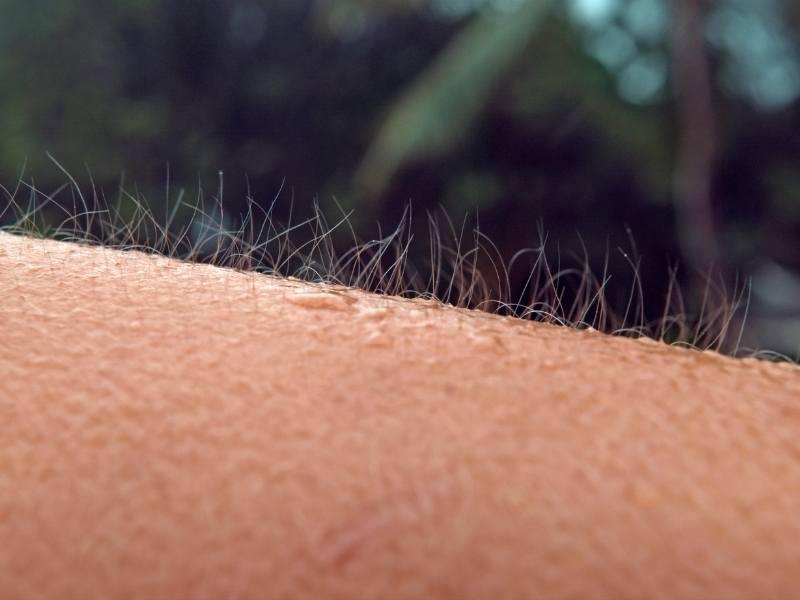
Its natural function in certain animals is to make them appear larger to predators when threatened.
A variety of factors can cause piloerection in dogs, such as fear, asserting dominance, excitement, or anxiety – all different forms of stimuli.
Do All Dogs Have Hackles?
Yes, all dogs have hackles, although the presence of hackles varies according to the breed.
It’s difficult to spot hackling in breeds with long, fluffy, or curly hair – such as poodles. Short-haired dogs tend to exhibit their piloerection more visibly.
Note: Raised hackles (normally) only last a few seconds, which is why it can be incredibly difficult to take clear photos of it occurring!
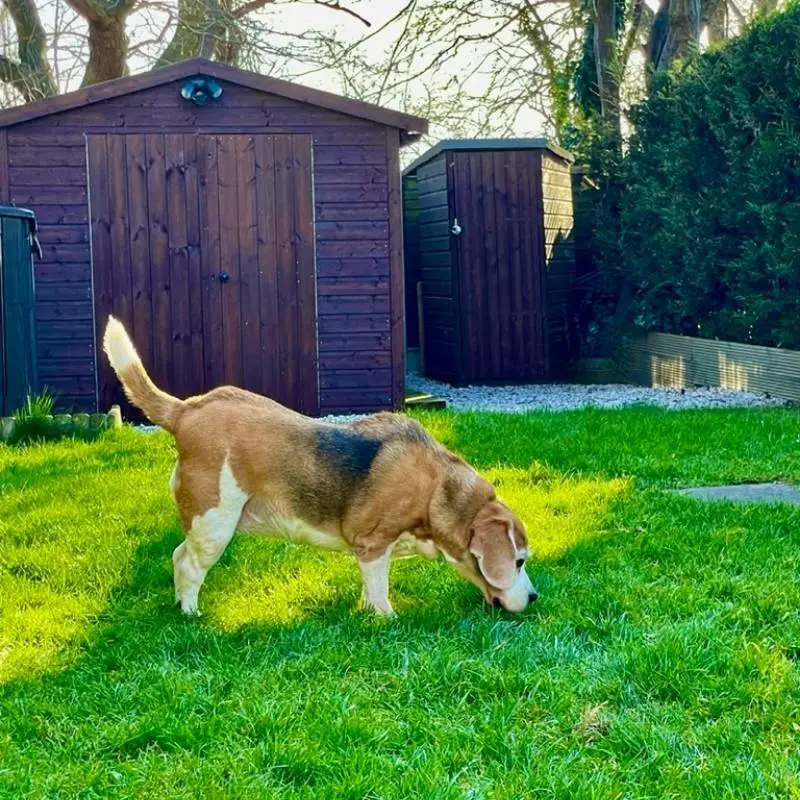
5 Reasons Why Dogs Raise Their Hackles
Raised hackles in dogs indicate that they are on high alert.
They might be experiencing a response brought on by fear, surprise, insecurity, excitement, or uncertainty about a situation.
It’s a physiological response to stimulation of the sympathetic nervous system that induces piloerection along the neck and back.
Anything from a sudden clap of thunder to the excitement of a visitor could cause hackling.
This isn’t something that dogs do consciously. Instead, it happens in the same way that the hairs on our arms stand on end when we experience a burst of adrenaline.
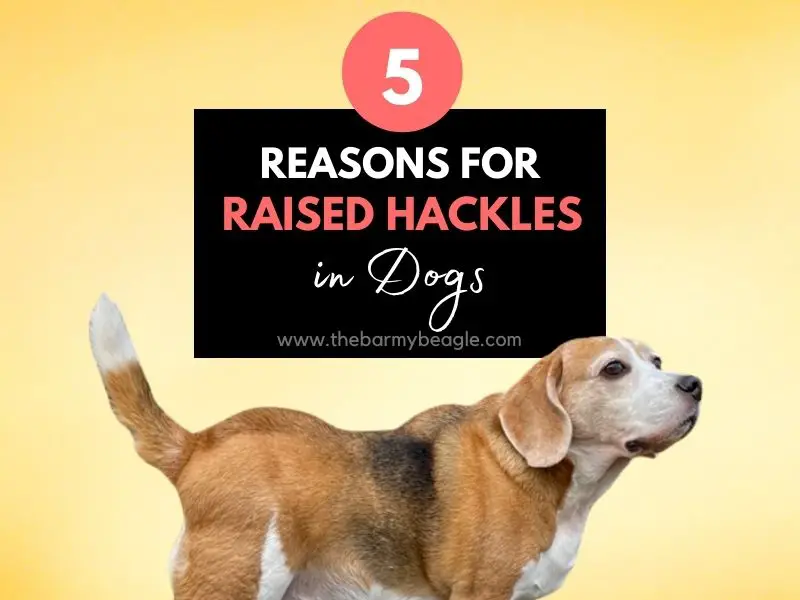
5 Common Reasons Why Dogs Raise Their Hackles:
1. Fear
Dogs can raise their hackles through fear of the unknown, or if they feel threatened by the presence of something.
This may be a dog-on-dog encounter where they feel intimidated by the other dog’s size and stature. Your small dog might raise its hackles in response to an overly large dog, for instance.
Fear can also be caused by loud or unexpected noises such as thunder or fireworks – anything that your dog isn’t used to or is expecting.
2. Surprise or Unpredictability
Dogs may raise their hackles when startled suddenly or unexpectedly. This could be the appearance of someone (or another dog) jumping out from around a corner, for example.
In these cases, you may notice that your dog’s tail is also tucked in between their legs as this is another way that dogs show they may be feeling anxious or scared.

3. Aggression / Dominance
Dogs may also raise their hackles to assert dominance over another dog or individual.
This can also occur during dog training when your dog is trying to establish who is in charge, for instance.
A dominant dog will raise their hackles and growl if they feel threatened by a dog who isn’t obeying them or is behaving in an over-excited manner.
4. Insecurity
Read more : When Are Hydrangeas In Season
If your dog is usually confident but suddenly starts raising its hackles for no reason, it could be a sign that they’re feeling insecure in the current situation.
This might be because of a change in their environment (a new baby or pet in the home), or because they are feeling uncertain about something new that has occurred.
5. Excitement
Dogs can also raise their hackles during playtime with another dog, or even you!
It’s usually combined with lots of tail wagging and is just a sign that they are incredibly stimulated or excited.
10 Important Cues with Raised Hackles
Raised hackles on their own might not tell you an awful lot, but when combined with other body language and cues, they can provide a more accurate picture of how your dog is feeling.
Here are 10 important things to look out for:
1. Lip Licking
Often seen when a dog is trying to show submission, lip licking can be a sign of nervousness or anxiety.
It is also used as a means to calm down other dogs, by communicating that they are no threat, in order to diffuse a tense situation.
2. Tail Wagging
A wagging tail can generally be seen as a sign of happiness, but that’s not always the case.
If it’s wagging low, this could be a sign that your dog is feeling threatened, and is still assessing the situation.
A fast-wagging tail coupled with hackles could be an indication of fear-based aggression rather than confidence-based aggression.
3. Tail Tucked Between Legs
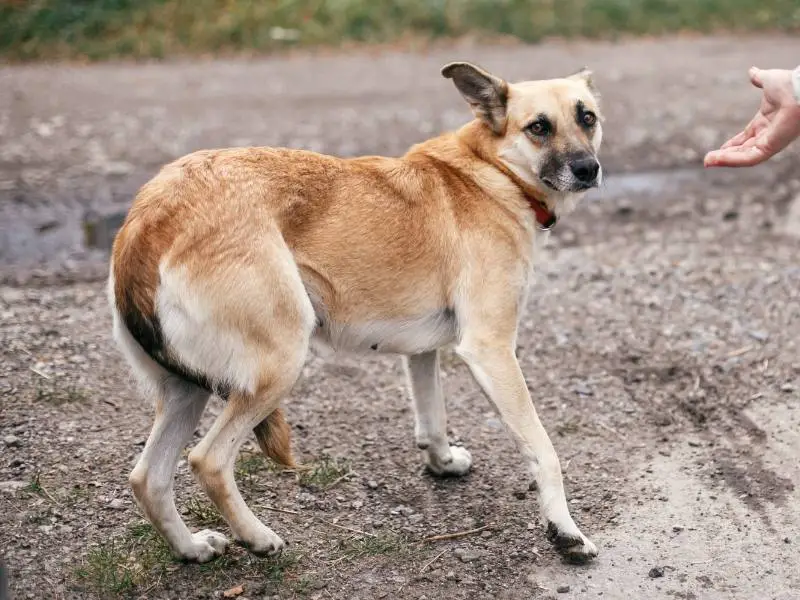
A dog that has its tail tucked between its legs is indicating that it feels scared and vulnerable.
This posture is often seen when dogs see or hear something that is causing them fear and anxiety.
4. Freezing in Place
Dogs will sometimes freeze in place when they feel threatened.
This can be a sign that they are trying to assess the situation and figure out what to do next, whilst carrying out their own risk assessment.
5. Ears Pricked Up
This indicates that the dog is alert and interested in what’s going on around it, and is normally a sign of confidence.
6. Ears Pinned Back

When your dog has raised hackles with their ears pinned back, they are likely to be fearful, defensive, or unsure about their surroundings.
7. Wide-Eyes
Similar to ears being pinned back, wide eyes are also a sign that the dog feels threatened by something or someone, and is on high alert.
8. Defensive Barking
Barking is a dog’s way of expressing itself vocally. Unlike humans, dogs can’t use words to tell us how they’re feeling, so barking gives you a good indication of how your dog perceives the situation around them.
Every dog owner should be able to distinguish the difference between a defensive bark vs a playful bark when it comes to their dog.
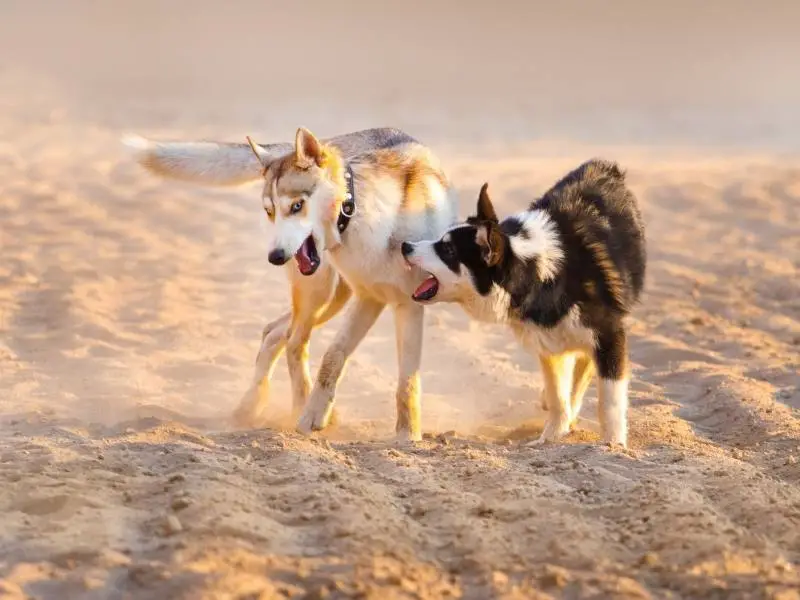
9. Growling
When coupled with raised hackles, growling is generally a dog’s way of saying “I don’t like this (or you), back off right now.”
It’s often accompanied by other defensive body language such as bared teeth.
10. Sniffing Rampage
Sniffing is a dog’s way of taking in information about their environment.
When a dog goes on a sniffing rampage with its hackles raised, they’ve usually been triggered by the scent of another animal.
This is most likely to occur in the dog’s own territory – like their backyard.
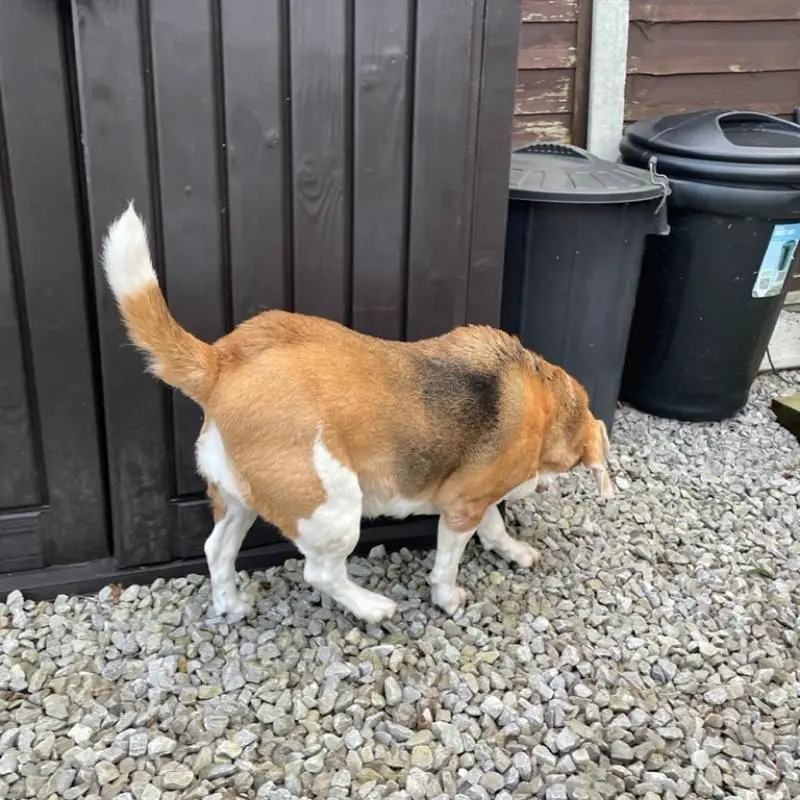
What Action Should You Take When Your Dog’s Hackles Are Raised?
When a dog raises its hackles it’s definitely time to pay attention to whatever it is that’s causing them to be overly stimulated, particularly when dealing with dogs or situations that you are unfamiliar with.
You may need to de-escalate the situation by removing your dog from the current environment they are in, or you may simply just need to observe their subsequent behavior.
The action you should take depends on the situation and the likely causes for stimulation, along with the other signs being displayed by your dog.
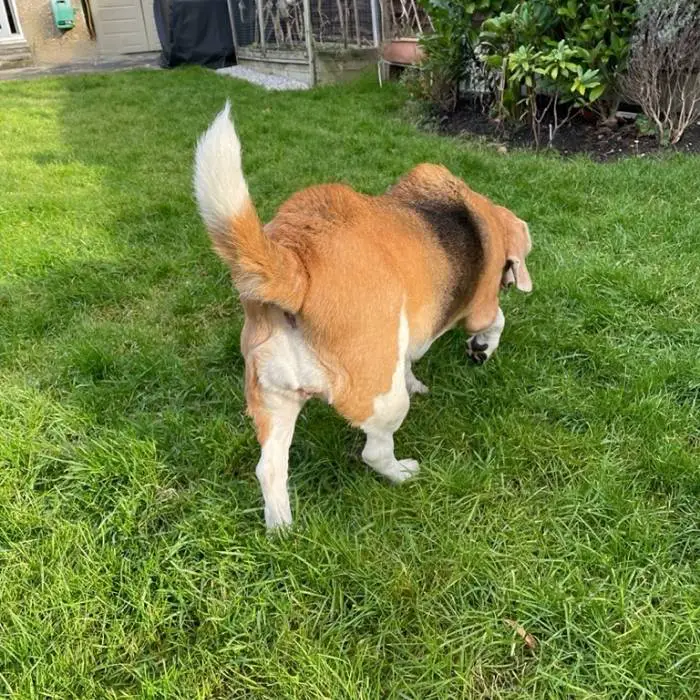
For example…
1. FEAR
Read more : When Do Target Holiday Hours Start
Situation: Your dog raises its hackles after hearing an unexpected (but non-threatening) loud noise.
What You Should Do:Try to replicate the sound to trick your dog into believing it was you, which can immediately reduce the perceived threat.
Carry on going about your business like the noise was nothing to worry about, helping to normalize and reassure them that there is no threat.
What Not To Do:The worst thing you can do in this situation is to spook your dog by saying things like “Ooooh what was that, go see what that was” or similar phrases that reinforce to your dog that there is an imminent threat.
Cuddling a frightened dog may seem like the right thing to do, but it could cause them to become overly dependent on you.
This can subsequently lead to your dog feeling extremely anxious, particularly when left at home on its own.
2. AGGRESSION / DOMINANCE
Situation:Your dog raises its hackles after being approached by another dog/puppy
What You Should Do:Your dog is on high alert, and you should be too. Keep a close eye on them to observe the interaction and relevant body language.
If they begin to growl, show their teeth, or bark defensively, this is likely to lead to either the other dog (and its owner) becoming distressed, or potentially being snapped at (or attacked) by your dog.
Call your dog back, do not give them a treat (indirectly rewarding unwanted behavior), and calmly put them on the leash before walking away.
What Not To Do:Do not ignore their raised hackles when they are in the presence of another dog, particularly if it is a dog they are meeting for the first time.
The other dog (especially playful puppies) may not understand the signs being displayed by yours, leading to them invading your dog’s personal space when it is not welcomed.
Also, avoid suddenly approaching your dog from behind, or startling them when they are showing any signs of potential aggression towards another dog.
Note: If you are really concerned by your dog’s raised hackles and behavior towards others, consider taking a professional online training course to help de-sensitize your dog and be calmer towards whatever is causing the issue. Our recommended course for this is the K9TI Masterclass
3. PLAYTIME
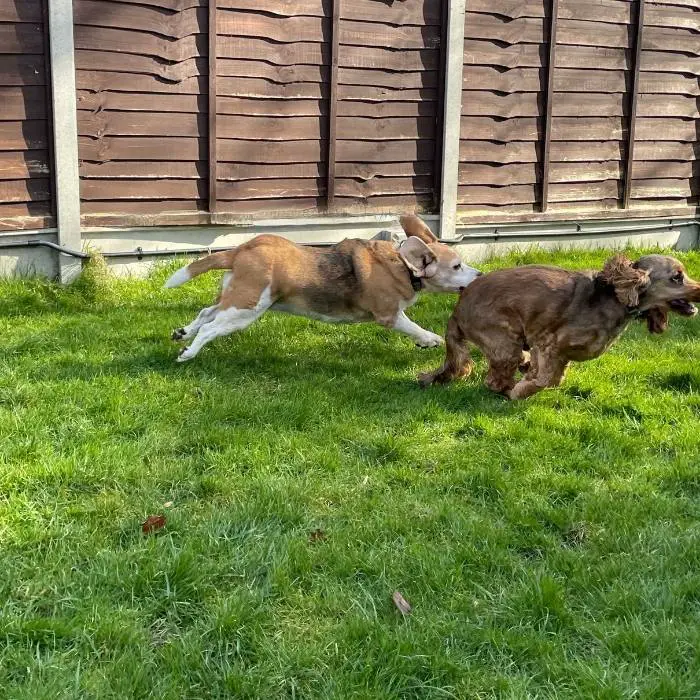
Situation:Your dog raises its hackles when playing with other dogs
What You Should Do:If your dog is playing happily with other dogs and its hackles are raised, there’s normally no need to worry – it’s a likely sign that they’re having a good time!
Raised hackles during playtime means that they are stimulated and excited, and unless accompanied by signs of aggression, there’s nothing to worry about.
This could also be a sign that they are asserting their dominance, which doesn’t always mean it’s likely to be followed by aggression.
What Not To Do:There’s no need to panic and tell your dog to stop playing or to calm down!
Your dog will not understand what they have done wrong, and could begin displaying other strange behaviors when socializing as a result of the confusion.
Unless the other dog’s owner disapproves of the playfulness, let them crack on with their fun!
How about Raised Hackles When a Dog is Sleeping?
Some people may wonder if hackling can occur when dogs are sleeping or dreaming. The answer is yes – dogs can raise their hackles in response to stimuli, even while they are asleep.
There is usually nothing to worry about. Dogs are naturally stimulated by their dreams on occasions, just like we are too!
This could be in response to a dream where your dog is feeling fearful or threatened, so make sure you don’t wake a sleeping dog with hackles (or any signs of aggression) as it could lead to you getting bitten.
Can I Get My Dog to Raise Its Hackles on Demand?
You are very unlikely to be able to replicate the type of stimulation or situation required to get your dog to raise its hackles.
Whilst raised hackles don’t always indicate stress, they can be a sign that your dog is feeling uncomfortable or threatened.
Dogs should never be forced into a situation where they may feel anxious or defensive in an attempt to see their hackles raised.
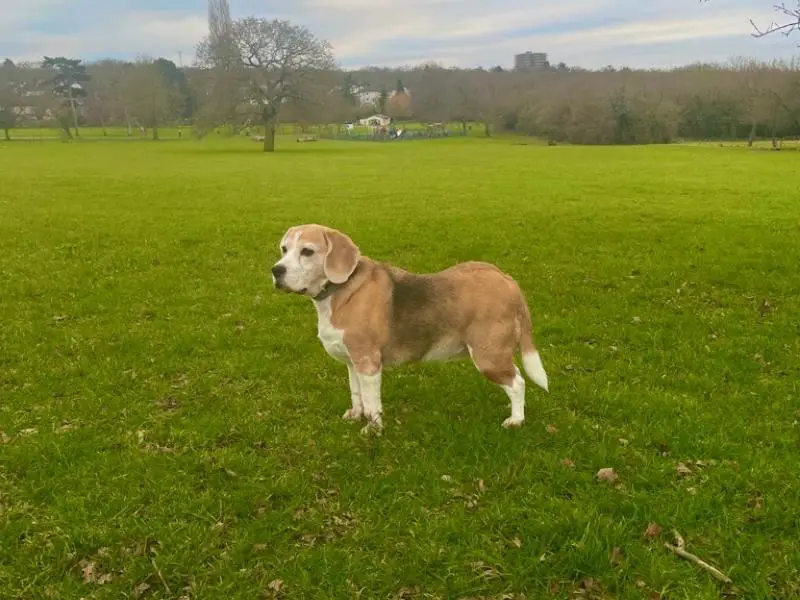
There’s no need to be alarmed by Raised Hackles
Every dog has hackles, but it’s more noticeable in some breeds. While raised hackles don’t always signal aggression or fear, it’s a good idea to stay vigilant and figure out what’s triggering it.
If you’re ever in doubt, just drop your questions in the comments. We always enjoy a good chat!
Further Reads:
- 15 Best Dog Training Tools & Gadgets
- 13 Top-Rated Online Dog Training Courses
- 24 Crate Training Dos and Don’ts
- 7 Reasons Why Dogs Wag Their Tails!
Source: https://t-tees.com
Category: WHEN
